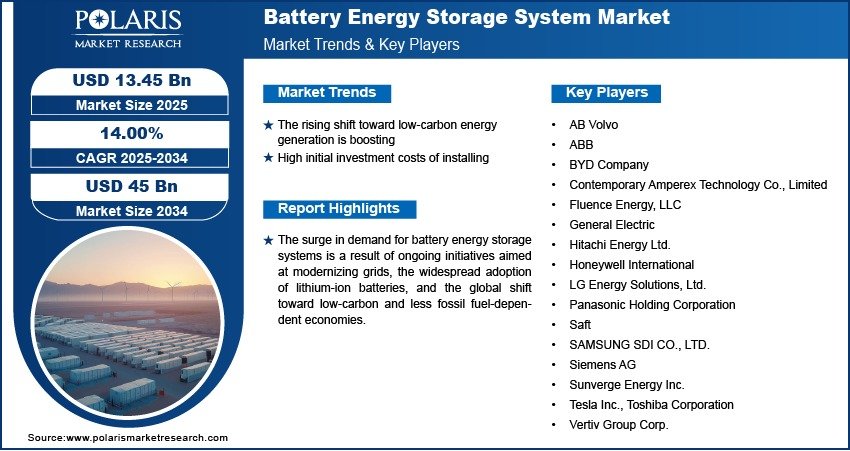Battery Energy Storage System Market Size Projected to Reach USD 45 Billion by 2034 | CAGR of 14.0%

The global Battery Energy Storage System Market was valued at USD 12.20 billion in 2024 and is projected to register a CAGR of 14.0% from 2025 to 2034. This strong growth trajectory is driven by the rising need to enhance grid reliability and flexibility amid the global shift towards renewable energy integration. Countries across the world are focusing on decarbonizing their energy mix and deploying storage systems to manage intermittent renewable generation sources such as solar and wind. Battery energy storage systems (BESS) are playing a critical role in enabling this transition by providing grid balancing, frequency regulation, and peak shaving functionalities.
Market Overview:
Battery Energy Storage Systems are designed to store electricity for use during periods of peak demand, grid instability, or energy outages. These systems are increasingly adopted in utility-scale energy projects, commercial infrastructures, and residential settings. The continuous drop in battery prices, improvements in lithium-ion battery technology, and the growing push for energy decentralization are significantly contributing to market expansion. Furthermore, regulatory support, along with funding for smart grid projects and renewable energy deployment, is creating a favorable environment for market growth.
Key Market Trends:
-
Accelerated Adoption of Lithium-Ion Batteries:
Lithium-ion remains the dominant battery chemistry due to its high energy density, long life cycle, and declining cost. Continuous research in material science is further boosting its adoption across utility-scale and residential applications. -
Renewable Energy Coupling with Storage:
The combination of solar PV or wind systems with battery storage is becoming more common to ensure energy availability during non-generation periods, making renewable energy more dispatchable. -
Growth in Behind-the-Meter Storage Solutions:
Businesses and homeowners are increasingly investing in battery systems to reduce reliance on the grid, lower energy bills, and ensure backup power during outages. -
Grid Modernization and Digitization Initiatives:
Governments and utilities are investing in smart grids integrated with energy storage to improve energy efficiency, enhance demand response, and enable real-time energy management. -
Expansion of Energy-as-a-Service (EaaS) Models:
Companies are offering battery energy storage as a service, allowing end-users to access energy storage without upfront capital investment, thus lowering entry barriers.
Market Size & Forecast:
|
Market size value in 2025 |
USD 13.45 billion |
|
Revenue Forecast in 2034 |
USD 45 billion |
|
CAGR |
26.7% from 2025 – 2034 |
Request for Free Sample:
Key Market Opportunities:
The battery energy storage system market holds vast potential, particularly in emerging economies where grid infrastructure is underdeveloped. Increasing investments in electrification and renewable energy, especially in Asia-Pacific and Africa, present significant opportunities. Moreover, supportive policies like tax incentives, subsidies, and renewable portfolio standards (RPS) are encouraging public and private sector participation in energy storage deployment. Technological innovations in solid-state batteries and AI-based battery management systems are also opening new avenues for market expansion.
Market Scope:
The battery energy storage system market encompasses various system types including front-of-the-meter and behind-the-meter solutions, as well as multiple battery chemistries such as lithium-ion, lead-acid, and flow batteries. Applications range from renewable integration, grid services, and energy arbitrage to residential backup and industrial peak load management. Geographically, North America and Europe lead the market due to early adoption and strong regulatory support, while Asia-Pacific is expected to witness the fastest growth, driven by rapid urbanization, rising electricity demand, and government-led clean energy initiatives.






